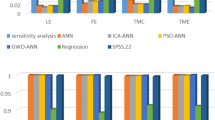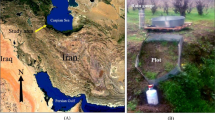Abstract
During the 21st century, artificial intelligence methods have been broadly applied in geosciences to simulate complex dynamic ecosystems, but the use of artificial intelligence (AI) methods to reproduce land-use/cover change (LUCC) in arid ecosystems remains rare. This paper presents a hybrid modeling approach to understand the complexity in LUCC. Fuzzy logic, equation-based systems, and expert systems are combined to predict LUCC as determined by water resources and other factors. The driving factors of LUCC in this study include climate change, ecological flooding, groundwater conditions, and human activities. The increase of natural flooding was found to be effective in preventing vegetation degradation. LUCCs are sensitive under different climate projections of RCP2.6, RCP4.5, and RCP8.5. Simulation results indicate that the increase of precipitation is not able to compensate for the additional evaporation losses resulting from temperature increases. The results indicate that grassland, shrub, and riparian forest regions will shrink in this study area. The change in grasslands has a strong negative correlation with the change in groundwater salinity, whereas forest change had a strong positive correlation with ecological flooding. The application of artificial intelligence to study LUCC can guide land management policies and make predictions regarding land degradation.
Similar content being viewed by others
References
Allen R G, Pereira L S, Raes D et al., 1998. Crop evapotranspiration: Guidelines for computing crop requirements. FAO Irrigation and Drainage Paper 56, Volume 300.
Arsanjani J J, Helbich M, Kainz W et al., 2013. Integration of logistic regression, Markov chain and cellular automata models to simulate urban expansion. International Journal of Applied Earth Observation and Geoinformation, 21: 265–275.
Banihabib M E, Shabestari M H, 2017. Fuzzy hybrid MCDM model for ranking the agricultural water demand management strategies in arid areas. Water Resources Management, 31(1): 495–513.
Bárdossy A, Disse M, 1993. Fuzzy rule-based models for infiltration. Water Resources Research, 29(2): 373–382.
Bergen K J, Johnson P A, Hoop M V et al., 2019. Machine learning for data-driven discovery in solid Earth geoscience. Science, 363(6433): 1299–1310.
Bui D T, Pradhan B, Revhaug I et al., 2015. A novel hybrid evidential belief function-based fuzzy logic model in spatial prediction of rainfall-induced shallow landslides in the Lang Son city area (Vietnam). Geomatics Natural Hazards & Risk, 6(3): 243–271.
Camarinha P I M, Canavesi V, Alvalá R C S, 2013. Shallow landslide prediction and analysis with risk assessment using a spatial model in a coastal region in the state of São Paulo, Brazil. Natural Hazards and Earth System Sciences, 14(9): 2449–2468.
Cao K, Huang B, Wang S et al., 2012. Sustainable land use optimization using Boundary-based Fast Genetic Algorithm. Computers, Environment and Urban Systems, 36(3): 257–269.
Carrero R, Navas F, Malvárez G et al., 2014. Artificial intelligence-based models to simulate land-use change around an estuary. Journal of Coastal Research, 70: 414–419.
Choubin B, Solaimani K, Habibnejad R M et al., 2017. Watershed classification by remote sensing indices: A fuzzy c — means clustering approach. Journal of Mountain Science, 14: 2053–2063.
Das J, Py F, Harvey J B J et al., 2015. Data-driven robotic sampling for marine ecosystem monitoring. The International Journal of Robotics Research, 34(12): 1435–1452.
DHI, 2014. MIKE HYDRO User Guide. DHI, Danmark, 57–187.
Doorenbos J, Kassam A H, 1979. Yield response to water. FAO Irrigation and Drainage Paper 33, volume 257.
Duethmann D, Menz C, Jiang T et al., 2016. Projections for headwater catchments of the Tarim River reveal glacier retreat and decreasing surface water availability but uncertainties are large. Environmental Research Letters, 11(5): 1–13.
Duh J D, Brown D G, 2007. Knowledge-informed Pareto simulated annealing for multi-objective spatial allocation. Computers, Environment and Urban Systems, 31(3): 253–281.
Duynhoven A V, Dragievi S, 2019. Analyzing the effects of temporal resolution and classification confidence for modeling land cover change with long short-term memory networks. Remote Sensing, 11(23): 2784–2810.
Fraser E, 2016. Computers as inventors: Legal and policy implications of artificial intelligence on patent law. Scripted, 13(3): 305–333.
Goodfellow I, Bengio Y, Courville A, 2016. Deep Learning. Cambridge: The MIT Press, 1–26.
Gustafson E J, Miranda B R, Bruijn A M G D et al., 2017. Do rising temperatures always increase forest productivity interacting effects of temperature, precipitation, cloudiness and soil texture on tree species growth and competition. Environmental Modelling and Software, 97: 171–183.
Han H, Yang C, Song J, 2015. Scenario simulation and the prediction of land use and land cover change in Bei**g, China. Sustainability, 7(4): 4260–4279.
Hao X, Chen Y, Li W, 2010. Hydraulic lift in Populus euphratica Oliv: From the desert riparian vegetation of the Tarim River Basin. Journal of Arid Environments, 74(8): 905–911.
Huang T M, Pang Z H, Chen Y N et al., 2013. Groundwater circulation relative to water quality and vegetation in an arid transitional zone linking oasis, desert and river. Science Bulletin, 25(10): 3088–3097.
IPCC, 2013. Climate change 2013: The physical science basis. Contribution of working group I to the fifth assessment report of the intergovernmental panel on climate change. United Kingdom and New York, NY, USA: Cambridge University Press, 56–72.
Islam K, Rahman M F, Jashimuddin M, 2018. Modeling land use change using cellular automata and artificial neural network: The case of Chunati Wildlife Sanctuary, Bangladesh. Ecological Indicators, 88: 439–453.
Khler J, Kuenzer C, 2020. Forecasting spatio-temporal dynamics on the land surface using Earth observation data: A review. Remote Sensing, 12(21): 3513–3546.
Liu X, Liang X, Li X et al., 2017. A future land use simulation model (FLUS) for simulating multiple land use scenarios by coupling human and natural effects. Landscape and Urban Planning, 168: 94–116.
Mendel J, 1995. Fuzzy logic systems for engineering: A tutorial. Proceedings of the IEEE, 83(3): 345–377.
Parker D C, Manson S M, Janssen M A et al., 2003. Multi-agent systems for the simulation of land-use and land-cover change: A review. Annals of the Association of American Geographers, 93(2): 314–337.
Patil S D, Gu Y, Dias F S A et al., 2017. Predicting the spectral information of future land cover using machine learning. International Journal of Remote Sensing, 38(19/20): 5592–5607.
Peng H, Thevs N, Ott K, 2014. Water distribution in the perspectives of stakeholders and water users in the Tarim River catchment, **njiang, China. Journal of Water Resource and Protection, 6(6): 543–555.
Poudel B C, Sathre R, Gustausson L et al., 2011. Effects of climate change on biomass production and substitution in north-central Sweden. Biomass & Bioenergy, 35(10): 4340–4355.
Qian Y, Zhou W, Yan J et al., 2015. Comparing machine learning classifiers for object-based land cover classification using very high resolution imagery. Remote Sensing, 7(1): 153–168.
Reichstein M, Camps-Valls G, Stevens B et al., 2019. Deep learning and process understanding for data-driven Earth system science. Nature, 566: 195–204.
Rogan J, Franklin J, Stow D et al., 2008. Map** land-cover modifications over large areas: A comparison of machine learning algorithms. Remote Sensing of Environment, 112(5): 2272–2283.
Sajedi-Hosseini F, Choubin B, Solaimani K et al., 2018. Spatial prediction of soil erosion susceptibility using a fuzzy analytical network process: Application of the fuzzy decision making trial and evaluation laboratory approach. Land Degradation and Development, 29(9): 3092–3103.
Schuster W M, 2018. Artificial intelligence and patent ownership. Washington and Lee Law Review, 75: 1945–2004.
Scott G J, England M R, Starms W A et al., 2017. Fusion of deep convolutional neural networks for land cover classification of high-resolution imagery. IEEE Geoscience and Remote Sensing Letters, 14(9): 1638–1642.
Sun L X, Yu Y, Gao Y T, 2021. Temporal and spatial variations of net primary productivity and its response to groundwater of a typical oasis in the Tarim Basin, China. Journal of Arid Land, 13(11): 1142–1154.
Termeh S V R, Kornejady A, Pourghasemi H R et al., 2018. Flood susceptibility map** using novel ensembles of adaptive neuro fuzzy inference system and metaheuristic algorithms. Science of the Total Environment, 615(15): 438–451.
Thevs N, Peng H Y, Rozi A et al., 2015. Water allocation and water consumption of irrigated agriculture and natural vegetation in the Aksu-Tarim River Basin, **njiang, China. Journal of Arid Environments, 112: 87–97.
Thomas F M, Jeschke M, Zhang X M et al., 2017. Stand structure and productivity of Populus euphratica along a gradient of groundwater distances at the Tarim River (NW China). Journal of Plant Ecology, 10(5): 753–764.
Tian Y, Hao M, Zhang H, 2020. Unsupervised change detection using spectrum-trend and shape similarity measure. Remote Sensing, 12: 3606–3625.
Tiné M, Perez L, Molowny-Horas R, 2019. Hybrid spatiotemporal simulation of future changes in open wetlands: A study of the abitibi-témiscamingue region, Québec, Canada. International Journal of Applied Earth Observation & Geoinformation, 74: 302–313.
Wang D, Menz C, Simon T et al., 2013. Regional dynamical downscaling with CCLM over East Asia. Meteorology and Atmospheric Physics, 121: 39–53.
Wang M, Cai L, Xu H et al., 2019. Predicting land use changes in northern China using logistic regression, cellular automata, and a Markov model. Arabian Journal of Geosciences, 12(24): 790–814.
Weinzierl T, Heider K, 2015. Assessment of future agricultural conditions in southwestern Africa using fuzzy logic and high-resolution climate model scenarios. Journal of the Geographical Society of Berlin, 146(4): 259–270.
Wu N, Silva E A, 2010. Artificial intelligence solutions for urban land dynamics: A review. Journal of Planning Literature, 24(3): 246–265.
Xu J H, Li W H, Hong Y L, 2014. A quantitative assessment on groundwater salinization in the Tarim River lower reaches, Northwest China. Sciences in Cold and Arid Regions, 6(1): 44–51.
Yan F, Liu L, Zhang Y et al., 2016. The research of dynamic variable fuzzy set assessment model in water quality evaluation. Water Resources Management, 30(1): 63–78.
Yu Y, Chen X, Disse M et al., 2020. Climate change in Central Asia: Sino-German cooperative research findings. Science Bulletin, 65(9): 689–692.
Yu Y, Disse M, Yu R et al., 2015. Large-scale hydrological modeling and decision-making for agricultural water consumption and allocation in the main stem Tarim River, China. Water, 7(6): 2821–2839.
Yu Y, Yu R, Chen X et al., 2017. Agricultural water allocation strategies along the oasis of Tarim River in Northwest China. Agricultural Water Management, 187: 24–36.
Zadeh L A, 1965. Fuzzy sets. Information and Control, 8(3): 338–353.
Zhang C, Zhang F, Guo S et al., 2018. Inexact nonlinear improved fuzzy chance-constrained programming model for irrigation water management under uncertainty. Journal of Hydrology, 556: 397–408.
Zhang Y M, Zhang D Y, Li W J et al., 2020. Characteristics and utilization of plant diversity and resources in Central Asia. Regional Sustainability, 1(1): 1–10.
Zhang Z, Hu H, Tian X et al., 2014. Groundwater dynamics under water-saving irrigation and implications for sustainable water management in an oasis: Tarim River Basin of western China. Hydrology and Earth System Sciences, 18(10): 3951–3967.
Zhao X, Xu H, Zhang P et al., 2013. Distribution of soil moisture and salinity in shelterbelts and its relationship with groundwater level in extreme arid area, northwest of China. Water and Environment Journal, 27(4): 453–461.
Author information
Authors and Affiliations
Corresponding author
Additional information
Foundation: Chinese Academy of Sciences “Light of West China” Program, No.2018-XBQNXZ-B-017; National Natural Science Foundation of China, No.42107084; Philosophy and Social Science Major Project funded by the Ministry of Education of the People’s Republic of China, No.20JZD026
Author: Yu Yang, Associate Professor, specialized in environmental change in arid lands.
Rights and permissions
About this article
Cite this article
Yu, Y., Cao, Y., Hou, D. et al. The study of artificial intelligence for predicting land use changes in an arid ecosystem. J. Geogr. Sci. 32, 717–734 (2022). https://doi.org/10.1007/s11442-022-1969-6
Received:
Accepted:
Published:
Issue Date:
DOI: https://doi.org/10.1007/s11442-022-1969-6




